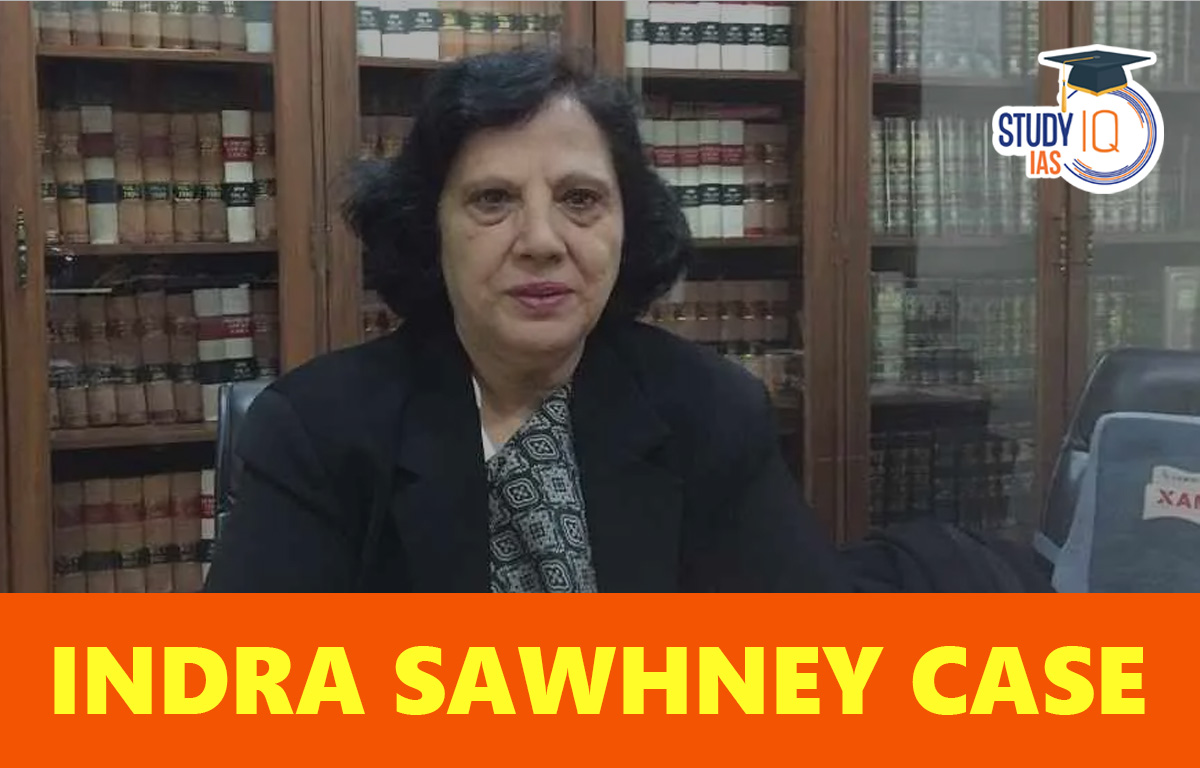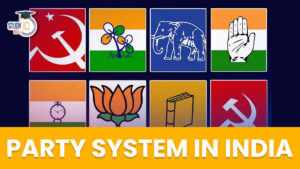Table of Contents
Indra Sawhney Case
The Indra Sawhney vs Union of India case, also known as the Mandal Commission case, is a key Supreme Court decision from 1992 that addressed reservations for Other Backward Classes (OBCs) in government jobs and education. This landmark ruling significantly influenced India’s reservation policies and sparked many debates and legal challenges.
| Some important points from the case: |
Overall, this judgment has had a lasting impact on affirmative action and future legal decisions in India. |
Read about: List of Chief Justice of India
Indra Sawhney Case Background
Kaka Kalelkar Commission
The First Backwards Class Commission, also known as the Kaka Kalelkar Commission, was established in 1953 in accordance with Article 340 of the Constitution of India (appointment of a commission to investigate the conditions of backward classes), but its 1955 report was essentially disregarded in 1961.
Mandal Commission
The Second Backwards Class Commission (Mandal Commission), established by the Janata Dal in January 1979 under the leadership of the then-prime minister Moraji Desai, published its final report in December 1980 with recommendations on how to advance SEBCs. In addition to the already-existing 22.5 per cent reservation for SCs and STs, this Mandal Commission Report advocated a government quota of 27 per cent for the SEBCs.
The Mandal Commission Report was put into practice under the P.V. Narasimha Rao-led Congress government in 1991 with a few modifications, including the introduction of the economic criterion in the granting of reservations by giving preference to the poorer sections of the SEBCs within the proposed 27 per cent quota and a further 10 per cent reservation grant to the economically challenged sections of the population not benefiting from any reservation schemes.
There was widespread violence, and India continued to lose a lot of people and property. After a two-year battle in which the Supreme Court attempted to strike a balance between judicial pragmatism and political opportunism, all writ petitions contesting the application of the Mandal Commission Report were finally moved to itself on September 11th, 1990.
Indra Sawhney vs Union of India Case Argument in Support
The parties favoured the recommendation by the Mandal commission and stated that it was the saviour for the future upliftment of the unprivileged groups of the country which would help the backward classes to improve their social and economic status in society. The initial recommendation for the upliftment of the unprivileged group was made by the Kaka Kalelkar Committee, 1953 which was followed by the Mandal Commission.
Indra Sawhney vs Union of India Case Argument in Against
It was asserted that the quota system creates progressive and regressive social strata and feeds the evil caste system. This was exacerbating societal issues and fostering interpersonal enmity. The idea of a welfare state would not become a reality until everyone has equal possibilities. Giving reservations based on caste violated the constitutional guarantee of equal opportunity for all, and this violation of a person’s fundamental rights would be very detrimental to society’s growth.
Indra Sawhney vs Union of India SC Judgement
The main verdict was written by Justice B.P. Jeevan Reddy, along with Justices M.H. Kania, M.N. Venkatachaliah, and A.M. Ahmadi. Justices P.B. Sawant and S. Ratnavel Pandian agreed with the decision, while Justices Dr. T.K. Thommen, Kuldip Singh, and R.M. Sahai offered dissenting opinions. In a 6:3 majority ruling, the Supreme Court upheld the P.V. Narasimha Rao government’s decision to implement a 27% quota for SEBCs based on the Mandal Commission Report, with some restrictions.
- Scope & Extent of Articles 16(1) and 16(4): Supreme Court held that Article 16(4) is not an exception to Article 16(1) and it must be read along in the harmony with Article 16(1).
- Exclusion of Creamy Layer: The advanced sections among the OBCs (the creamy layer) should be excluded from the list of beneficiaries of reservation.
- Non-applicable to Promotions: Only initial appointments should be subject to reservations; promotions shouldn’t. Any reservations made for promotions can only be kept for a total of five years (i.e., up to 1997).
- Reserved Quota: Except in rare circumstances, the overall reserved quota shouldn’t be higher than 50%. Every year, this regulation should be followed.
- Carry Forward Rule: The ‘carry forward rule’ in case of unfilled (backlog) vacancies is valid. But the criteria of 50% rule should not be violated in any case.
- Statutory Body: A permanent statutory body should be established to examine complaints of over-inclusion and under-inclusion in the list of OBCs.
Read More: Article 15 of Indian Constitution
Indra Sawhney vs Union of India Government Steps
With regard to the above rulings given by the Supreme Court in the Indra Sawhney Case, the government of India has taken the following steps:
- Ram Nandan Committee: For the identification of the creamy layer among the OBCs, Ram Nandan Committee was appointed. In 1993 the committee submitted the report, which was accepted by the government.
- National Commission for Backward Classes: The National Commission for Backward Classes was established in 1993 through a Parliamentary statute. Its task was to investigate complaints of the under-, over-, or non-inclusion of any class of residents in the list of economically disadvantaged groups for the purpose of job reservation. The 102nd Amendment Act of 2018 gave the commission a constitutional status and expanded its duties. The amendment added a new Article 338-B to the constitution for this reason.
- Reservation in Promotions: In 1995, the 77th Amendment Act was passed to overturn the decision regarding reservations in promotions. Later, with retroactive effect from June 1995, the 85th Amendment Act of 2001 provided for “consequential seniority” in the case of promotion by virtue of the rule of reservation for the government employees belonging to the SCs and STs.
- Provision for Backlog Vacancies: The 81st Amendment Act of 2000 was also passed to overturn the decision about backlog vacancies. Another new provision was introduced to Article 16 by the 81st Amendment Act, which gives the State the authority to treat any unfilled reserved vacancies from one year as a different class of vacancies that must be filled in the next year or years. As a result, the 50% cap on reservations for backlog vacancies was lifted.
- Tamil Nadu Reservation Act: The 76th Amendment Act of 1994 has placed the Tamil Nadu Reservations Act of 1994 in the Ninth Schedule to protect it from judicial review as it exceeds the 50 % ceiling. Tamil Nadu provides a reservation of 50% to the OBCs, 18% to the SCs & 1 % to the STs, making the total reservation to be 69%.
Read More: Article 16 of Indian Constitution
Indra Sawhney Case Summary
In the Indra Sawhney case, the court made an attempt to find an appropriate solution that maintains a fine balance between society and the rights of the underprivileged/backward classes. The only issue at hand was the Supreme Court’s ruling on the legitimacy of the Mandal Commission Report. In reality, the Apex Court was tasked with making a lot of complex decisions that had broad implications. The following categories can be used to group the significant problems in this historic case:
- Application and scope of Articles 16(1) and 16(4).
- Exclusion of creamy layer
- Reserved quota and carry forward rule
- Non-applicable to promotions
Read More: Article 14 of Indian Constitution
After Indra Sawhney case
After the Indra Sawhney case, several changes were made to the reservation system. In 1995, the Parliament passed the 77th Amendment to the Constitution, adding clause [4A] to Article 16. This allowed states to reserve seats for Scheduled Castes (SC) and Scheduled Tribes (ST) in promotions if these communities were not well represented in public jobs.
In 2006, the Supreme Court upheld this provision in the M. Nagaraj vs. Union of India case, setting three requirements:
- SC and ST must be socially and educationally backward.
- They must lack adequate representation in public employment.
- It should not harm administrative efficiency.
Following this amendment, several states enacted related laws. For example, Karnataka’s law in 2018, which extended seniority to government servants promoted through reservation, was upheld by the Supreme Court in 2019.
Earlier, the Karnataka law from 2002 was ruled unconstitutional because the state hadn’t assessed the need for reservation properly. Additionally, in February 2020, the Supreme Court clarified that there is no fundamental right to claim reservation in promotions, as seen in the Mukesh Kumar vs. State of Uttarakhand case.
Constitution and Reservation
77th Constitutional Amendment Act (1995):
The Indra Sawhney verdict allowed reservation only for initial appointments, not promotions.
Article 16(4A) was added, enabling states to reserve promotions for SC/ST employees if they are underrepresented.
81st Constitutional Amendment Act (2000):
Introduced Article 16(4B), allowing unfilled SC/ST quotas from one year to be carried forward and treated separately in the next year.
85th Constitutional Amendment Act (2001):
Allowed for reservation in promotions with “consequential seniority” for SC/ST government servants, effective from June 1995.
103rd Amendment (2019):
Provided 10% reservation for the Economically Weaker Section (EWS).
Article 335:
States that the claims of SCs and STs must be considered while ensuring the efficiency of administration in appointments to Union and State services.
Indra Sawhney Case UPSC
Due to The Constitution (One Hundred and Second Amendment Act of 2018), the National Commission for Backward Classes (NCBC) has legal standing. The backward strata of people are being uplifted by numerous government agencies and NGOs. However, it seems that the aforementioned questions are purposefully being left unaddressed. Even though our constitutional values have improved overall, there are still many villages in India where people will ask about caste before speaking, and there have been numerous instances of caste-based violence where members of the underprivileged classes have been beaten until they are blue in the face.
The tale of two India has continued even after thirty years after Indra Sawhney’s Judgement. On one side, there are supposed reverse discrimination victims who harbour anti-reservation attitudes, and on the other, Dalit beatings continue. On one side, there is judicial pragmatism, and on the other, there is political opportunism. Is caste-based discrimination in India too pervasive a societal stigma to ever be eradicated? India of the future could serve as an example where people are only recognised for their job and not for their caste. Let political opportunism refrain from turning this dream into one that is purely functional.


 List of Governor of States in India, Con...
List of Governor of States in India, Con...
 Maharashtra Bill to Curb Urban Naxalism,...
Maharashtra Bill to Curb Urban Naxalism,...
 Party System in India, Feature, Importan...
Party System in India, Feature, Importan...





















